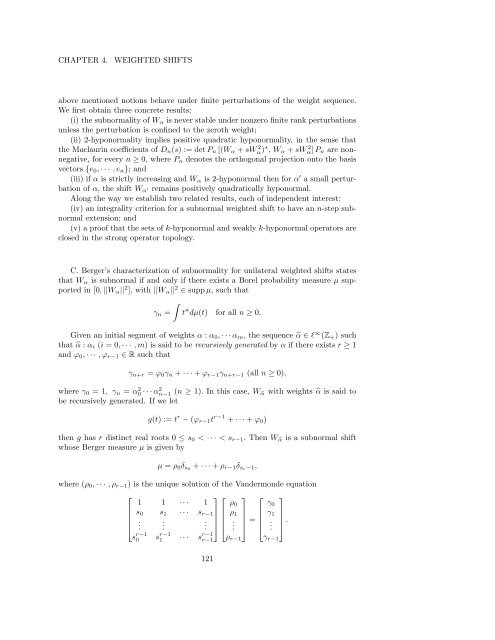Woo Young Lee Lecture Notes on Operator Theory
Woo Young Lee Lecture Notes on Operator Theory
Woo Young Lee Lecture Notes on Operator Theory
Create successful ePaper yourself
Turn your PDF publications into a flip-book with our unique Google optimized e-Paper software.
CHAPTER 4.<br />
WEIGHTED SHIFTS<br />
above menti<strong>on</strong>ed noti<strong>on</strong>s behave under finite perturbati<strong>on</strong>s of the weight sequence.<br />
We first obtain three c<strong>on</strong>crete results:<br />
(i) the subnormality of W α is never stable under n<strong>on</strong>zero finite rank perturbati<strong>on</strong>s<br />
unless the perturbati<strong>on</strong> is c<strong>on</strong>fined to the zeroth weight;<br />
(ii) 2-hyp<strong>on</strong>ormality implies positive quadratic hyp<strong>on</strong>ormality, in the sense that<br />
the Maclaurin coefficients of D n (s) := det P n [(W α + sWα) 2 ∗ , W α + sWα] 2 P n are n<strong>on</strong>negative,<br />
for every n ≥ 0, where P n denotes the orthog<strong>on</strong>al projecti<strong>on</strong> <strong>on</strong>to the basis<br />
vectors {e 0 , · · · , e n }; and<br />
(iii) if α is strictly increasing and W α is 2-hyp<strong>on</strong>ormal then for α ′ a small perturbati<strong>on</strong><br />
of α, the shift W α ′ remains positively quadratically hyp<strong>on</strong>ormal.<br />
Al<strong>on</strong>g the way we establish two related results, each of independent interest:<br />
(iv) an integrality criteri<strong>on</strong> for a subnormal weighted shift to have an n-step subnormal<br />
extensi<strong>on</strong>; and<br />
(v) a proof that the sets of k-hyp<strong>on</strong>ormal and weakly k-hyp<strong>on</strong>ormal operators are<br />
closed in the str<strong>on</strong>g operator topology.<br />
C. Berger’s characterizati<strong>on</strong> of subnormality for unilateral weighted shifts states<br />
that W α is subnormal if and <strong>on</strong>ly if there exists a Borel probability measure µ supported<br />
in [0, ||W α || 2 ], with ||W α || 2 ∈ supp µ, such that<br />
∫<br />
γ n = t n dµ(t) for all n ≥ 0.<br />
Given an initial segment of weights α : α 0 , · · · α m , the sequence ̂α ∈ l ∞ (Z + ) such<br />
that ̂α : α i (i = 0, · · · , m) is said to be recursively generated by α if there exists r ≥ 1<br />
and φ 0 , · · · , φ r−1 ∈ R such that<br />
γ n+r = φ 0 γ n + · · · + φ r−1 γ n+r−1 (all n ≥ 0),<br />
where γ 0 = 1, γ n = α 2 0 · · · α 2 n−1 (n ≥ 1). In this case, Ŵα with weights ̂α is said to<br />
be recursively generated. If we let<br />
g(t) := t r − (φ r−1 t r−1 + · · · + φ 0 )<br />
then g has r distinct real roots 0 ≤ s 0 < · · · < s r−1 . Then Ŵα is a subnormal shift<br />
whose Berger measure µ is given by<br />
µ = ρ 0 δ s0 + · · · + ρ r−1 δ sr−1,<br />
where (ρ 0 , · · · , ρ r−1 ) is the unique soluti<strong>on</strong> of the Vanderm<strong>on</strong>de equati<strong>on</strong><br />
⎡<br />
⎤ ⎡ ⎤ ⎡ ⎤<br />
1 1 · · · 1 ρ 0 γ 0<br />
s 0 s 1 · · · s r−1<br />
ρ 1<br />
⎢<br />
⎥ ⎢<br />
⎣ . . . ⎦ ⎣<br />
⎥<br />
. ⎦ = γ 1<br />
⎢<br />
⎣<br />
⎥<br />
. ⎦ .<br />
s r−1<br />
0 s r−1<br />
1 · · · s r−1<br />
r−1<br />
ρ r−1 γ r−1<br />
121













